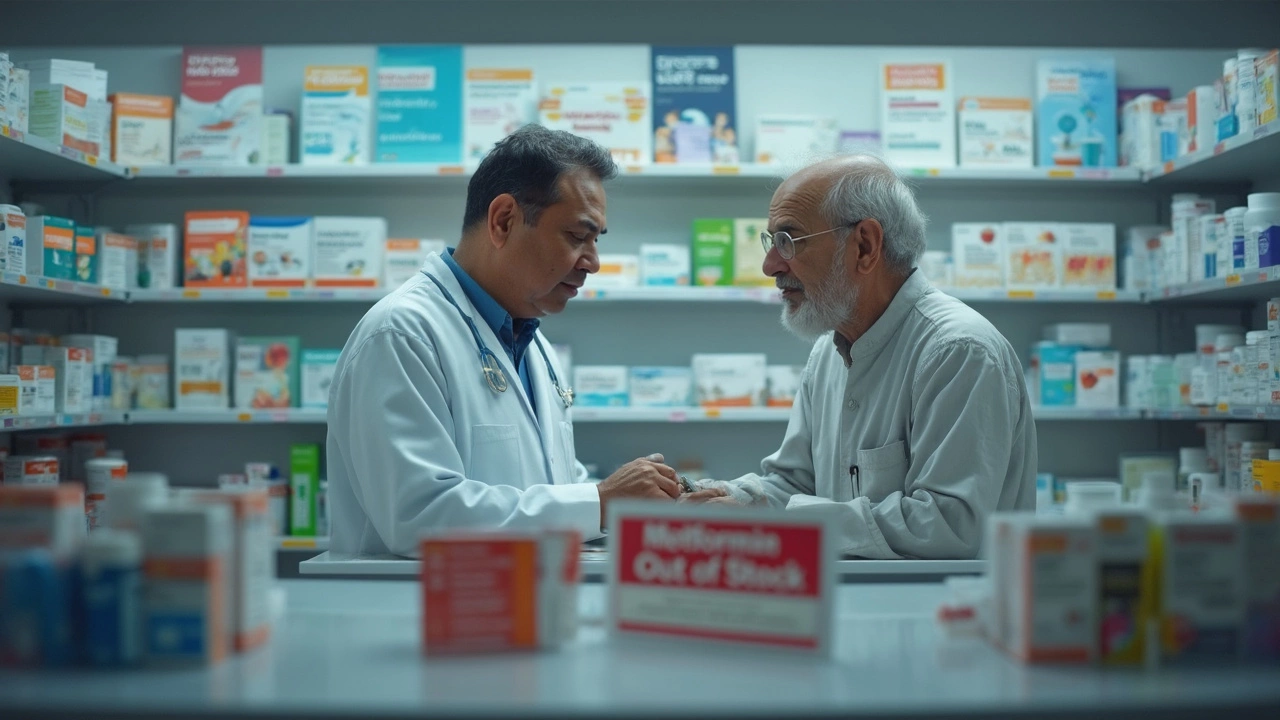
Imagine reaching for your regular diabetes pill at the pharmacy, only to hear, “Sorry, it’s not available.” That’s exactly what’s been happening with metformin lately, and a lot of folks are asking why. If metformin is such an old standby for type 2 diabetes, what could possibly go wrong?
The short answer: not every bottle is being yanked from the shelves, but some are. The most common reason? Safety recalls. In 2020 and 2021, a few metformin extended-release brands were pulled due to trace contamination with NDMA, a possible cancer risk. These recalls were targeted—so your whole medicine cabinet isn’t suddenly unsafe, but it’s smart to double-check your prescription label.
Don’t panic, though. This isn’t a total ban. Most immediate-release metformin, the kind most people take, is still safe and available. If you’ve heard folks rumbling about shortages, that’s often because pharmacies are juggling supplies or waiting on cleared, uncontaminated stock. Sometimes temporary shortages look like a full-on discontinuation, but that’s not usually the real story.
So what’s the bottom line for you? Know what type of metformin you have, and check for any recall notifications. If your specific brand is affected, your doctor or pharmacist can switch you to an approved option or discuss a different med altogether. Shadow, my dog, may not understand why I keep reading recall news, but if it keeps my health on track, that’s a trade I’ll take any day.
- The Real Reasons Metformin Is Being Pulled
- Which Metformin Products Are Actually Affected
- What To Do If Your Metformin Is Discontinued
- Alternatives and Steps to Stay On Track
The Real Reasons Metformin Is Being Pulled
People keep hearing that metformin is being discontinued, but the details are a bit more complicated. The main reason certain batches of this diabetes medication have been pulled comes down to something called NDMA contamination. NDMA (N-Nitrosodimethylamine) is a chemical that, in high enough amounts, might bump up your cancer risk if you swallow it for a long time.
Back in 2020, the FDA started checking several diabetes medicines, and they flagged some metformin extended-release brands because NDMA levels were slightly above the "acceptable daily intake." Once this got out, pharmacies started taking affected batches off their shelves. But here's the thing—not all metformin, and definitely not every brand or every version, has this problem.
Alongside safety recalls, there have also been some plain old supply and manufacturing problems. Drug companies sometimes run into issues making enough safe tablets, especially if they're switching suppliers or factories. Regulations keep getting tighter, too, especially for drugs people need to take every day like metformin. If a factory slips up, even in a tiny way, shipments can get paused or slowed while everything gets checked.
Here’s a quick breakdown of why metformin was pulled in the last couple years:
- NDMA contamination above safe limits in some extended-release versions
- FDA and EMA (Europe's medicine agency) pressure on companies for tighter quality control
- Supply chain hiccups or factory closures
- Pharmacies running out temporarily while waiting for new stock
A few brands (like Apotex, Amneal, and Teva) announced voluntary recalls on their metformin XR (extended-release) pills. Below is a simple look at some recent metformin recalls:
| Year | Company | Product | Reason |
|---|---|---|---|
| 2020 | Amneal | Metformin ER | NDMA above limit |
| 2020 | Apotex | Metformin ER | NDMA above limit |
| 2021 | Teva | Metformin ER | NDMA above limit |
For most folks taking metformin, there’s no need to worry unless you’re on one of the specific recalled brands or lots. The immediate-release stuff (the most commonly prescribed kind) was almost never affected. If you ever get a recall notice, hang on to it and talk to your doctor or pharmacist before making any changes.
Which Metformin Products Are Actually Affected
So, here’s the deal: not all metformin is getting pulled. The main issue kicked off with some metformin extended-release (ER) tablets—mostly the kind that slowly release the drug in your system. Immediate-release (IR) types, the classic pills most folks get, are rarely affected. The trouble started when several ER brands showed NDMA levels—an industrial byproduct and possible carcinogen—that went over the FDA’s safety limit.
Back in 2020 and 2021, the U.S. Food and Drug Administration (FDA) released lists identifying which batches were pulled from shelves. Here are some notable brands and specific lots that got yanked:
- Apotex Corp (500mg ER tablets, specific lots)
- Amneal Pharmaceuticals (500mg and 750mg ER, select batches)
- Lupin Pharmaceuticals (both 500mg and 1000mg ER)
- Teva Pharmaceuticals (500mg ER, certain lots)
- Marketer ranbaxy (various strengths ER tabs)
If you want stats, check out this simplified recall table based on FDA reports:
| Brand/Manufacturer | Type | Strengths | Recall Year |
|---|---|---|---|
| Apotex | Extended-Release | 500 mg | 2020 |
| Amneal | Extended-Release | 500 mg, 750 mg | 2020 |
| Lupin | Extended-Release | 500 mg, 1000 mg | 2020-2021 |
| Teva | Extended-Release | 500 mg | 2020 |
| Marketer ranbaxy | Extended-Release | All strengths | 2020 |
Here’s what matters: Immediate-release (IR) versions—like the ones most people pop—never tested above NDMA safety limits and are still widely available. If you only see “metformin” on your bottle without “ER” or “extended-release,” you’re probably in the clear.
Always double-check the label for “ER” or brand names connected with recent recalls. Your pharmacist should know these details inside out. Bringing your bottle in for a look isn’t overkill—it’s exactly what the FDA recommends if you’re unsure.

What To Do If Your Metformin Is Discontinued
If you find out your metformin prescription isn't available, don't skip your meds or make quick changes on your own. Skipping doses messes with your blood sugar and could make things worse fast. Here’s what you should do instead:
- Contact your doctor right away. Let them know exactly what’s happening—if your pharmacy can’t supply your medicine, or if you got a recall notice. Bring your actual prescription or pill bottle when you call or visit, so it's clear which brand, strength, and release type you’re on.
- Ask your pharmacy if they have a different manufacturer’s version. Sometimes, only specific lots or brands are affected, so you might be able to get an alternative right away. Pharmacists deal with these hiccups all the time and can tell you about what's in stock locally.
- Do not try to split, crush, or change how you take the medicine without asking your healthcare provider first. Extended-release and immediate-release pills work differently, so swapping isn’t always safe or effective.
- If your pharmacy can’t help, ask your doctor about switching to another approved diabetes medication. There are several alternatives, like sulfonylureas, DPP-4 inhibitors, or SGLT2 inhibitors. What works depends on your health, kidney function, and insurance coverage.
- Keep an eye on your blood sugar. If you’re missing doses because of the discontinuation, check your levels more often. Jot down the numbers to share with your doctor. Changes in meds might mean temporary highs or lows, so don’t guess—use hard numbers.
If you ever feel confused by what you’re told at the pharmacy or doctor's office, ask questions. It’s your health, and getting clear answers makes it less stressful. When in doubt, double-check anything you’re unsure about—better safe than sorry with metformin or any diabetes medicine.
Alternatives and Steps to Stay On Track
If you've been taking metformin and suddenly your pharmacy’s out, it’s normal to feel a bit stuck. The good news? You’re not out of options. Several other diabetes meds can help control blood sugar when metformin isn't available or isn’t an option.
Doctors usually look at three main things when picking an alternative: how well it works, what side effects to expect, and how much it costs. Here’s a quick table showing some of the most common alternatives and how they stack up:
| Medication | How It Works | Main Side Effects |
|---|---|---|
| SGLT2 inhibitors (like empagliflozin, dapagliflozin) | Lowers blood sugar by helping the kidneys get rid of it in urine | Increased urination, risk of genital infections |
| GLP-1 receptor agonists (like semaglutide, liraglutide) | Makes you feel fuller and increases insulin after meals | Nausea, possible weight loss, rarely pancreatitis |
| Sulfonylureas (like glipizide, glyburide) | Boosts insulin output from the pancreas | Low blood sugar, weight gain |
| DPP-4 inhibitors (like sitagliptin) | Helps the body release more insulin as needed | Usually mild side effects, possible headaches |
Now, switching meds isn’t something to do solo. If your usual prescription is discontinued or recalled, here’s what you should do:
- Call your doctor or care team first—don’t just stop taking your pills.
- Ask about switching within the metformin family (sometimes your pharmacy may stock a different, safe version).
- If a new medication is needed, work with your healthcare provider to watch for side effects and tweak the dose as needed.
- Keep an eye on your blood sugar more often during the switch—it may bounce around while your body adjusts.
A quick tip: let your provider know about any other health conditions. Some alternatives are better for folks with heart or kidney concerns. For example, SGLT2 inhibitors can help with kidney and heart protection, but may not fit everyone. Being honest about medication costs is smart too—some new diabetes drugs can be pricey, while others are cheap generics.
If you’re worried about getting your meds on time, ask the pharmacy if they can set up automatic refills or help find another supply. Some patients have luck at big box stores that stock more options.
Recalls and shortages are annoying, but you don’t have to manage it alone. Staying in touch with your healthcare provider and checking your blood sugar regularly is the best way to avoid a real problem. There are always steps to keep diabetes under control, even if your regular go-to isn’t on the shelf right now.





Rohan Talvani
I am a manufacturing expert with over 15 years of experience in streamlining production processes and enhancing operational efficiency. My work often takes me into the technical nitty-gritty of production, but I have a keen interest in writing about medicine in India—an intersection of tradition and modern practices that captivates me. I strive to incorporate innovative approaches in everything I do, whether in my professional role or as an author. My passion for writing about health topics stems from a strong belief in knowledge sharing and its potential to bring about positive changes.
view all postsWrite a comment